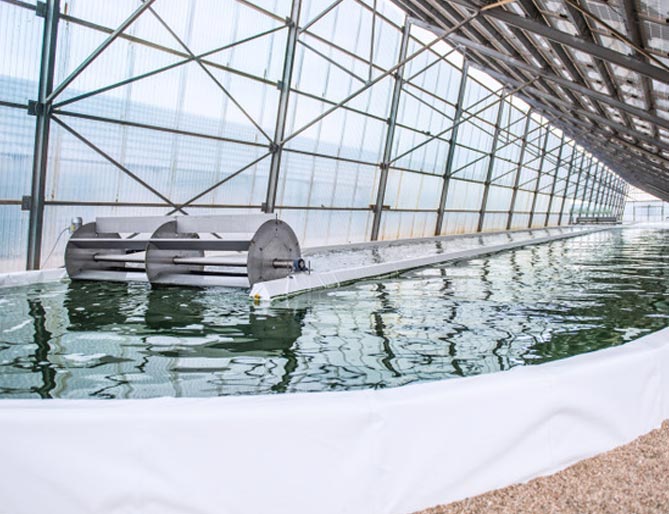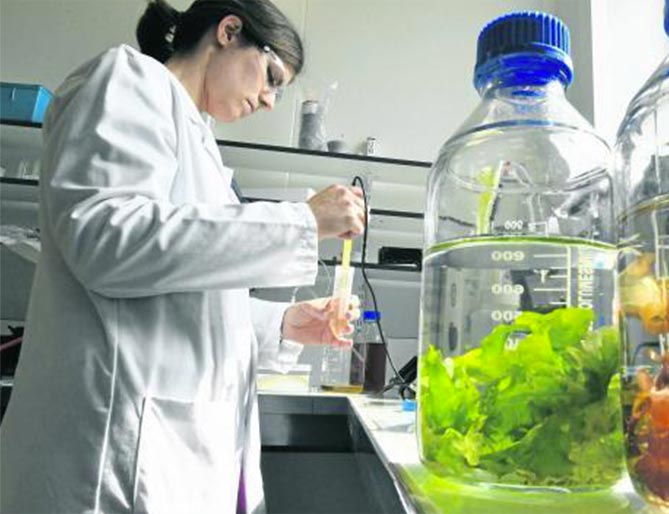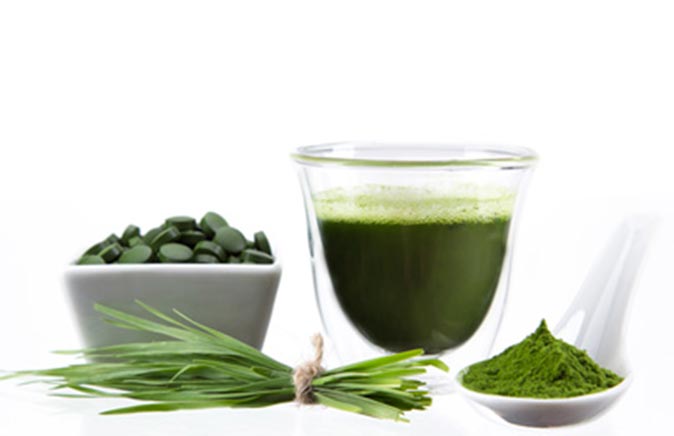
Spiralg work
package flowchart


WP 1
Microalgae production – Livegreen
The main objective of WP1 is to reduce the cost of Spirulina production in order to reach the market under economic and environmentally sustainable conditions, and this can be achieved by :
– developing automated processes to reduce the labour requirements and enhance/stabilise the productivity
– installing renewable energy resources (solar heating and photovoltaic panels) to reduce the energy requirements
– use alternative feeding products to reduce the costly nutrient inputs Moreover, in the perspectives of SPIRALG, which is based on the production of the blue pigment phycocyanin as a primary product, WP1 will also focus on processes to enhance phycocyanin content during cultivation.
Metabolic orientation will be achieved by modifying:
– light intensity to improve phycocyanin production in terms of quantity and quality
– nutrient recipe to optimise growth parameters and phycocyanin synthesis first transformation process parameters (dewatering, drying…) to stabilise the biomass for optimal phycocyanin extraction.
—
WP1 will work in close relationship with WP2 to adjust biomass production parameters to the aimed phycocyanin quantity and quality, and complementary information brought by WP3 on the quality of co-products can also help adjust this production.
WP1 will provide the necessary information to WP4 for the market analysis (cost related production parameters) and to WP5 for the Life Cycle Assessment analysis.


WP 2
Phycocyanin extraction – GreenSea
The main objective of WP2 is to test and optimise the use of specific modern technologies to efficiently extract the blue pigment phycocyanin for the Spirulina microalgae. Improvements are focused on keys extraction points and are expected in:
– the phycocyanin extraction production flow
– specific new equipment selected for this extraction
– innovative implementation of the overall extraction process
WP2 will hence provide a full integrated continuous production line of phycocyanin from Spirulina.
WP2 will work in close relationship with WP1 to provide the analytical guidelines and factual results of phycocyanin content and quality, so WP1 can adjust the production parameters accordingly. WP2 will also work closely with WP3 by exchanging residues for co-product investigation.
WP2 will contribute to the overall economic analysis of the project (WP4). Indeed, GREENSEA already produces and commercialises phycocyanin for the pharmaceutical, cosmetic, food and feed markets. As such, WP1 will provide to the consortium a precise, but together a general, view of the needs, drawbacks and improvement margins for the production of a high quality phycocyanin. WP2 will also provide the necessary information to WP5 for the Life Cycle Analysis of the overall value chain.


WP 3
Co-product valorisation – Algaia and Mial
The main objective of WP3 is to establish an integrated sustainable co-extraction pathway obtained from residues after phycocyanin extraction to commercial co-products and ingredients, thereby deploying a new full value chain of the Spirulina biomass. Several steps are to be implemented in order to achieve this goal, which are :
– to characterise the initial biomass before phycocyanin extraction in order to evaluate the effect of this extraction step on potential valuable co-products
– to develop efficient preservation processes in order to stabilise the biomass residues and end-products
– to apply novel and eco-friendly extraction techniques and separation systems able to be implemented from laboratory to pilot scale in the view of an industrial development.
– to demonstrate the technical interest of using full (or separated) fractions of co-products for the plant and animal health sectors – to test more specific peptide and carbohydrate high value fractions in the human health sector (antioxydants, properties against cardiovascular diseases)
—
WP3 will bring major effort in selecting efficient and environmentally sustainable technologies, adapted to the targeted fractions, without losing the focus of economic viability of the overall production chain.
WP3 will work in close relationship with WP1 to provide the analytical guidelines and factual results of biomass product quality, so WP1 can adjust the production parameters accordingly. WP3 will also work closely with WP2 by exchanging residues for co-product investigation. WP3 will contribute to the overall economic analysis of the project (WP4) and will also provide the necessary information to WP5 for the Life Cycle Analysis of the overall value chain.


WP 4
Market analysis – Mial
The main objective of WP4 is to provide an in-depth economic analysis of the potential market opportunities as well as the challenges to overcome. WP4 will thereby provide a guidance on the value of selected co-products and help steer the consortium towards valorisation synergies. The economic analysis of the whole value chain will involve :
– a market analysis covering the potential product range targeted by SPIRALG and for the European market
– a consumer analysis in order to finger out future trends and demands – a final business plan over the complete value chain of SPIRALG
—
Key performance indicators will be defined and controlled to show the contribution of the project to the utilization of as much of the produced valuable biomass as possible in a most beneficial and sustainable way. Special focus will be held on the co-valorisation of products, new products, that can generate high product margins.
WP4 will work closely with WP1, WP2 and WP3 in order to integrate the necessary information as inputs for the economic analysis. WP4 will also exchange with WP5 in order to adjust economic choices to environmental LCA targets.


WP 5
Life Cycle Analysis – UCD
The main objective of WP5 is to undertake a comprehensive sustainability evaluation of the project to ensure that there is a reduction of at least 10 % in the carbon footprint associated with the production of phycocyanin from Spirulina.
The sustainability of the processes for conversion of algae to bio-based products will be explored through integrated life cycle assessment (LCA) of the integrated biorefinery and industrial symbiosis using data collected from WP1, WP2, WP3, WP4 and WP5, focusing on appropriate environmental, social and economic methods in the context of LCA.


WP 6
Project Management – all partners
Although led by the coordinator Algaia, the SPIRALG project management is supported by the overall consortium. The main objectives are :
– To steer the project, ensure being on time and inside the budget
– To ensure internal share of information and completion of deliverables
– To assure reporting and documentation of deliverables
– To prepare an exploitation plan of the achieved results and findings
– The dissemination of results via the various channels of the project partners
Regarding the small size of the consortium (5 partners), rapid interactions and reactivity are expected to facilitate not only management goals but also the overall implementation of the project.



